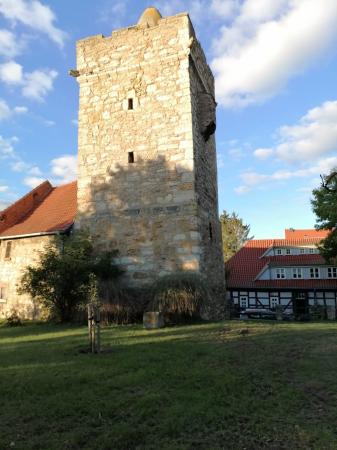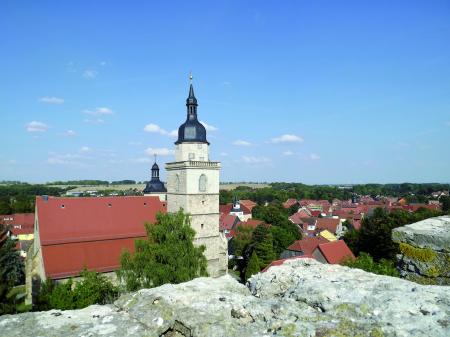Fronveste
-
viergeschossiger, gotischer Wohnturm mit Nebengelass
-
1465 erbaut
-
18,50 m Höhe
-
Grundriss rechteckig mit geringfügigen Abweichungen
Die Fronveste ist die imposanteste Turmanlage unserer Stadt. Der Turm selbst wurde auf einem künstlich aufgeschütteten Hügel errichtet und steht südlich der Stadt auf dem Weichberg. Der Erdhügel ist noch teilweise im Aufgang zum Museum sowie westlich des Grundstückes Schulberg Nr. 6 zu erkennen und ist zwischen 1,30 m und 1,50 m hoch. Der Turm wurde ursprünglich als viergeschossiger Wohnturm mit beheizbarer Kemenate gebaut, an der sich Wohn- und Wirtschaftsgebäude anschlossen. Das 1. Obergeschoss hat einen hohen und mit einem Kreuzrippengewölbe versehenen Raum.
An der westlichen Seite des Raumes befand sich der Kamin, dessen Rauchabzugsöffnung von hier bis in die Turmspitze führte. Dies ist an der rußgeschwärzten Wand über der Rauchabzugsöffnung noch sehr gut zu erkennen. Der innere Aufbau des Turmes zeigt, dass die Zugänge alle von der Westseite aus einem angebauten Gebäude erfolgten. Im Osten des Turmes befindet sich der Aborterker. Der Turm selbst schließt mit einer durch Zinnen bewehrten Plattform ab, die durch den aufgesetzten Turmkegel betreten werden kann. Die gesamte Anlage war mit einer Mauer oder einem Wall umschlossen und diente ursprünglich dem Schutz der Salzstraße. Die Salzstraße war ein mittelalterlicher Handelsweg, der im Bereich des Weichbergtores und der Hauptkirche in die Stadt hineinführte. Mit Beginn des Baues der Stadtmauer auf dem Weichberg verlor die Anlage ihre Eigenständigkeit als kleine Lehensburg. Turm und Gebäude wurden als wichtiger Eckpfeiler neben den anderen Stadttürmen in das Verteidigungssystem der Stadt integriert. Drittes und viertes Geschoss des Turmes dienten fortan der Verteidigung der Stadt. Im 3. Obergeschoss war dies jedoch nur eingeschränkt möglich, da Fenster und Schießscharten hier nach Süden und Westen angelegt sind. Erst das vierte Geschoss bildete mit der Ausrichtung der Schießstände in alle 4 Himmelsrichtungen eine optimale Verteidigungsplattform. Am Turm selbst ist nicht erkennbar, wo die von Osten kommende Stadtmauer anschloss. Aufgrund der Anlage des Abortes und der Tür zum ersten Geschoss ist davon auszugehen, dass der Turm vor der Mauer stand. Im Jahr 1758 diente die Fronveste als Gefängnis für einen berühmt-berüchtigten Räuber, der im Volksmund „Schwarzer Fritz“ genannt wurde. 1762 wurde der Turm in einen Gefängnisturm umgebaut. Dies ist gut erkennbar an den beiden zusätzlich eingebauten Gefängniszellen im dritten Obergeschoss. Nach Beendigung des 2. Weltkrieges behielt die Fronveste noch einige Jahre ihre Funktion als Gefängnisturm. Die letzten Insassen waren Schwarzhändler. Noch heute bietet die Aussichtsplattform des Turmes einen atemberaubenden Ausblick auf das umliegende Thüringer Land.
-
four-storey, gothic residential tower with ancillary room
-
1465 built
-
18.50 m Height
-
Floor plan rectangular with slight deviations
The Fronveste is the most impressive tower of our city. The tower itself was built on an artificially raised hill and stands south of the town on the Weichberg . The mound is still partially visible in the staircase to the museum and west of the property Schulberg No. 6 and is between 1.30 m and 1.50 m high. The tower was originally built as a four-storey residential tower with heated bower, connected to the residential and farm buildings. The first floor has a high and with a ribbed vaulted room. On the western side of the room there was the chimney whose smoke vent led from here to the top of the tower. This can be seen very well on the sootblackened wall above the smoke vent. The internal structure of the tower shows that the entrances were all from the west side of an attached building. In the east of the tower is the toilet in a projecting alcove. The tower itself ends with a platform reinforced by pinnacles, which can be entered through the attached tower cone. The entire complex was enclosed by a wall or a rampart and originally served to protect the Salt road. The Salzstraße was a medieval trade route, which led into the city in the area of the Weichbergtor (Weichberg gate) and the main church. With the beginning of the construction of the city wall on the soft mountain, the building complex lost its independence as a small feudal tenure castle. The tower and buildings have been integrated into the city's defence system as an important cornerstone next to the other city towers. From then on, the third and fourth floors of the tower served to defend the city. On the third floor, however, this was only possible to a limited extent, since windows and loopholes are laid out here to the south and west. Only the fourth floor formed an optimal defence platform with the alignment of the shooting ranges in all four directions. The tower itself does not show where the city wall coming from the east joined. Due to the installation of the abortion and the door to the first floor, it can be assumed that the tower stood in front of the wall. In 1758, the Fronveste served as a prison for a notorious robber popularly known as "Schwarzer Fritz" (Black Fritz) . In 1762, the tower was converted into a prison tower. This is easily recognizable by the two additionally installed prison cells on the third floor. After the end of the Second World War, the Fronveste retained its function as a prison tower for some years. The last inmates were bootleggers. Even today, the observation deck of the tower offers a breath-taking view of the surrounding Thuringia countryside. The building adjacent to the tower houses the Museum of the Fronveste , which cannot only be visited on the “ Day of the open monument ” . Tower and museum can be visited from April to October every 2nd and 4th Sunday between 2 and 5 p.m. You are welcome to arrange guided tours outside the opening times via the city information in the tourist information “Haus des Gastes” in the Kurstraße. Phone: +49 36041 57076 or E-Mail:
Heute befindet sich in diesem imposanten Bauwerksensemble das Museum der Stadt Bad Tennstedt, welches liebevoll eingerichtet ist. Jeweils von April bis Oktober steht die Anlage jeden 2. und 4. Sonntag im Monat dem Besucher von 14.00 Uhr bis 17.00 Uhr offen, gut erkennbar an der weiß-blauen Fahne an der Turmspitze. Zum Tag des offenen Denkmals können Turm und Museum in der Zeit von 10.00 Uhr bis 18.00 Uhr besichtigt werden. Außerhalb der vorgenannten Termine können Sie sich gern innerhalb einer Stadtführung dort umschauen oder einen private Besichtigung vereinbaren. Bitte wenden Sie sich diesbezüglich an unsere Touristinformation unter +49 36041 57076.

Fronveste mit St. Trinitatiskirche

winterliche Impressionen

Blick über Tennstedt







